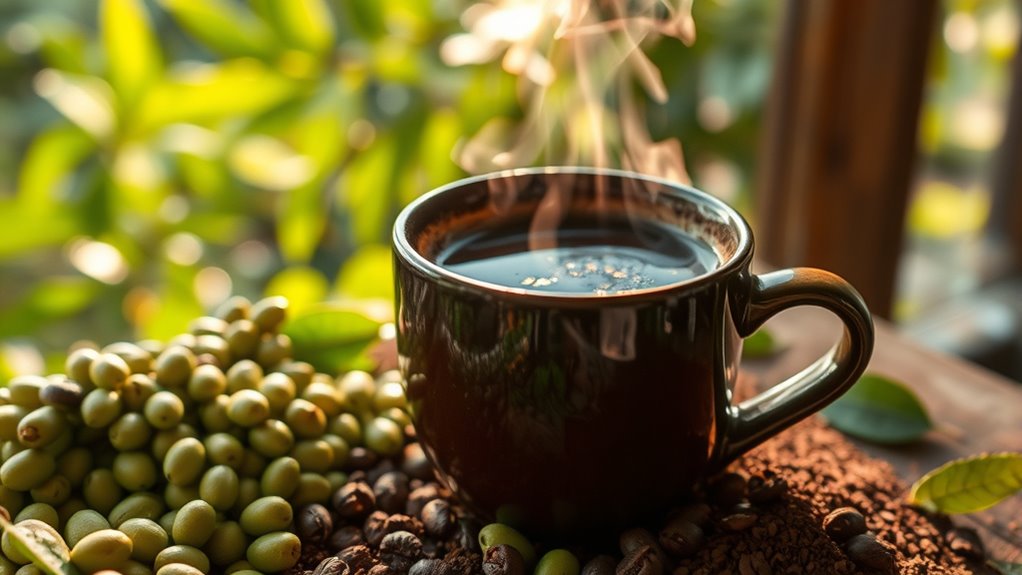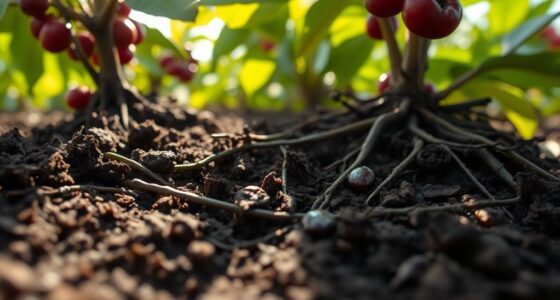Colombian coffee offers a unique taste with its medium to high acidity and smooth body. You’ll notice bright fruity notes like red berries and green apple, complemented by chocolatey undertones and hints of caramel. Factors like high altitude and a tropical climate enhance its complexity, while various regions create distinct profiles. Sustainable farming practices guarantee the quality and availability for future generations. Keep exploring to uncover more fascinating details about Colombian coffee and its exceptional flavors.
Key Takeaways
- Colombian coffee features medium to high acidity with a smooth body, complemented by bright fruity notes like red berries and green apple.
- The chocolatey undertones and hints of caramel create a complex flavor profile that rounds out each cup with a clean finish.
- Regional varieties, such as Huila and Antioquia, contribute unique flavors, ranging from floral notes to rich chocolatey profiles.
- High altitude and wet processing methods enhance the coffee’s bright acidity and fruity characteristics, making Colombian coffee distinctive.
- Sustainable farming practices, including fair trade and organic methods, ensure quality while promoting environmental health and farmer welfare.
The Signature Flavor Profile of Colombian Coffee

When you take a sip of Colombian coffee, you’re greeted by a signature flavor profile that’s hard to resist.
This unique taste stems from the high altitude where the coffee beans flourish, resulting in a balance of medium to high acidity and a smooth body. You’ll often notice bright fruity notes, like red berries and green apple, harmoniously combined with chocolatey undertones and a hint of caramel.
The commitment to quality shines through, as Colombian coffee mainly features Arabica varieties such as Caturra, Typica, and Castillo.
Colombian coffee showcases a dedication to quality, primarily featuring exquisite Arabica varieties like Caturra, Typica, and Castillo.
Regional variations enhance this experience: Huila offers red fruits and floral hints, Cauca brings citrus and tropical flavors, while Antioquia delights with rich chocolatey and nutty tones.
Enjoy the clean finish that rounds out each cup.
Factors Influencing Taste
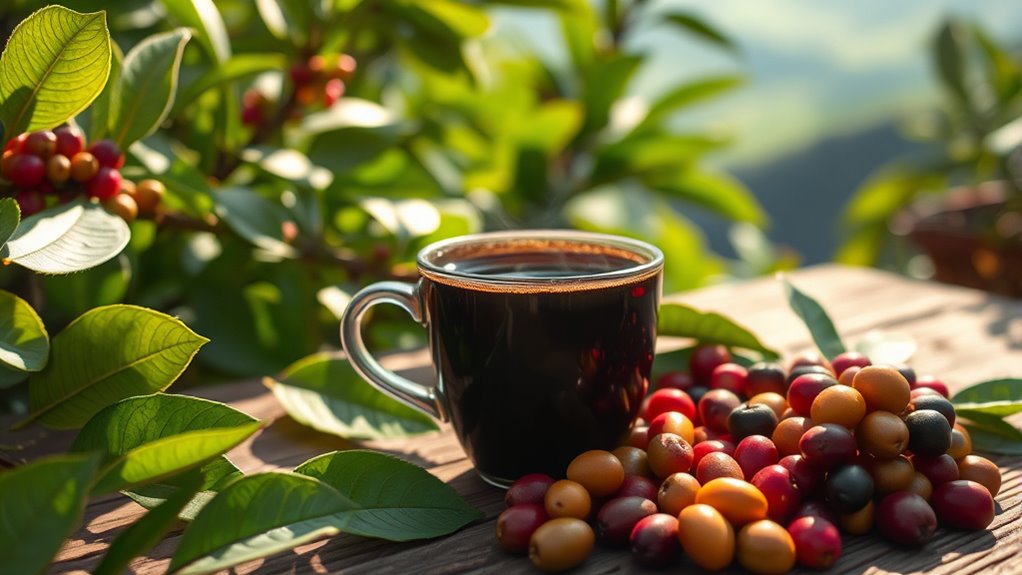
The signature taste of Colombian coffee doesn’t exist in a vacuum; it’s shaped by several key factors. High altitude plays a vital role, enhancing acidity and creating complex flavor profiles that coffee enthusiasts adore.
Exclusively made from superior quality Arabica beans, Colombian coffee boasts unique characteristics that set it apart from Robusta varieties. Common types like Caturra, Typica, and Castillo contribute their distinct flavors, while the wet processing method accentuates bright acidity and highlights fruity and floral notes.
Additionally, the tropical climate and variations in microclimates and soil across regions like Huila, Antioquia, and Nariño influence the taste even further. Sustainable farming practices also guarantee that these exceptional beans are cultivated responsibly, preserving their quality for future generations.
Regional Varieties and Unique Coffee Profiles

Exploring Colombia’s diverse coffee regions reveals a tapestry of unique flavor profiles that captivate coffee lovers. Each area contributes distinct characteristics to Colombian coffee.
For instance, Huila’s high altitude yields coffee cherries with bright acidity and floral notes, while Antioquia’s beans are full-bodied and feature nutty, chocolatey flavors.
Nariño stands out for its vibrant acidity and citrus undertones, thanks to its volcanic soil and elevation. In Cauca, you’ll find medium-bodied coffee with delightful tropical fruit and caramel notes, reflecting the region’s microclimates.
Tolima, on the other hand, is known for its rich, smooth chocolatey profiles.
These regional varieties showcase the complexity and high quality of Colombian coffee, making every cup a unique experience.
The Importance of Sustainability in Coffee Production
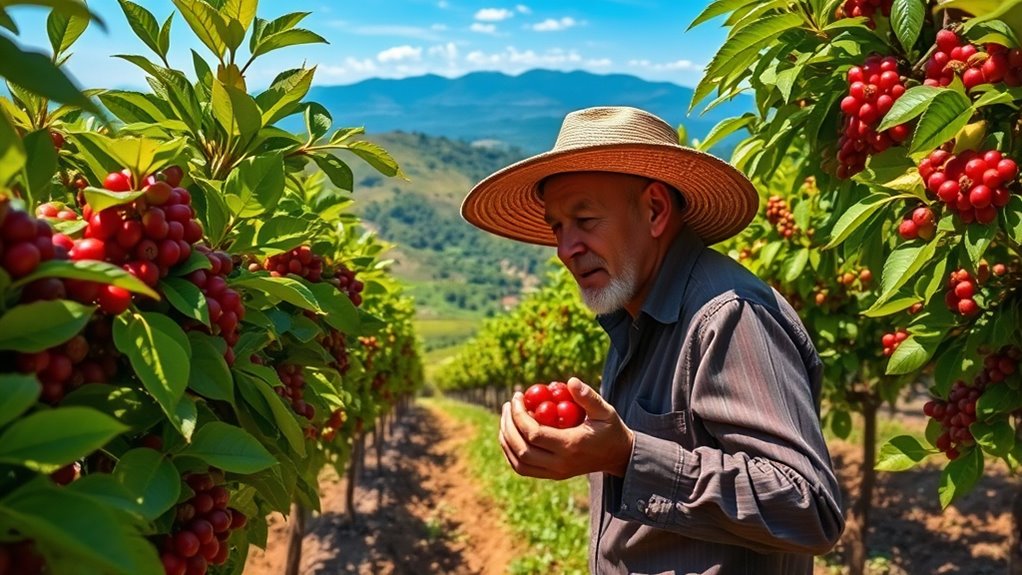
Sustainability in coffee production isn’t just a trend; it’s essential for preserving the rich heritage and quality of Colombian coffee. By adopting ethical practices, Colombian farmers enhance both the quality and sustainability of their crops.
Using organic fertilizers and water conservation techniques, they guarantee long-term viability while promoting biodiversity across the coffee landscape. This commitment to quality not only improves the coffee itself but also supports ecosystem health and resilience against climate change.
Additionally, fair trade principles allow farmers to receive fair compensation, enabling them to invest in their communities. By focusing on environmental stewardship, the coffee industry aligns with global coffee efforts to combat environmental degradation, guaranteeing future generations can enjoy the unique taste of Colombian coffee.
Brewing the Perfect Cup of Colombian Coffee
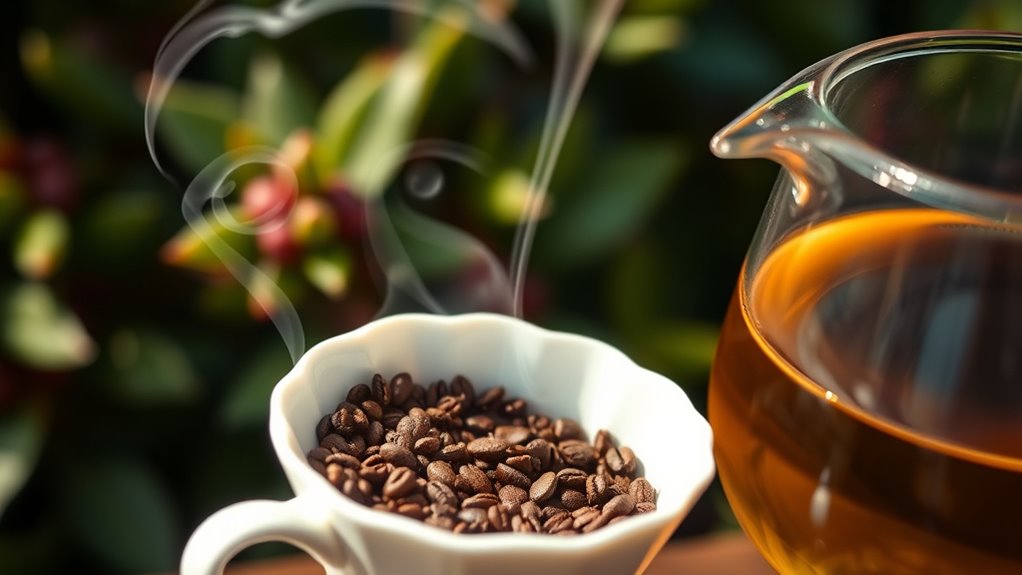
Understanding the rich heritage of Colombian coffee sets the stage for brewing it to perfection. To truly savor its unique flavor profile, start with high-quality beans. Grind them just before brewing to retain those aromatic oils.
| Brewing Method | Flavor Notes |
|---|---|
| Pour-Over | Bright acidity |
| French Press | Rich chocolatey tones |
| Espresso | Bold and intense |
| Cold Brew | Smooth and sweet |
Use water heated between 195°F to 205°F (90°C to 96°C) for the best extraction. Experiment with grind size and coffee-to-water ratios to enhance your coffee experience. Each brewing method reveals different dimensions of Colombian coffee, making each cup a delightful journey.
Frequently Asked Questions
What Is Unique About Colombian Coffee?
Colombian coffee’s uniqueness lies in its high-quality Arabica beans, grown in the Andes Mountains.
You’ll notice its bright acidity and complex flavors, influenced by specific regions. For instance, Huila offers fruity notes, while Antioquia brings chocolatey undertones.
The careful hand-picking process guarantees only the ripest cherries make it to your cup, resulting in a smooth and balanced brew.
You’ll appreciate the natural sweetness and subtle hints of chocolate and caramel in each sip.
What Is Colombian Coffee Supposed to Taste Like?
When you sip Colombian coffee, you’re in for a delightful experience.
You’ll notice its medium to high acidity and smooth body, complemented by a natural sweetness. Expect vibrant fruity notes like red berries and green apple, along with hints of chocolate and caramel.
Each region offers unique flavors, so whether you’re tasting Huila or Antioquia, you’ll appreciate the complex, well-balanced profile that makes Colombian coffee truly special.
What Is Considered the Best Coffee in the World?
When you think about the best coffee in the world, Colombian coffee often comes to mind. Its unique flavor profile, with smooth body and bright acidity, sets it apart.
You’ll find notes of chocolate and caramel that delight your palate. The high-altitude growing conditions, combined with meticulous hand-picking, guarantee you’re getting only the finest quality.
Many coffee connoisseurs agree that Colombian coffee deserves its prestigious reputation among the world’s top coffees.
What Is the Difference Between Colombian Supremo and Excelso Coffee?
Imagine you’re at a café, deciding between a smooth Colombian Supremo and a lively Excelso.
The difference lies in their size and flavor. Supremo beans, larger and screen size 17 and above, offer a classic, mild taste that’s comforting.
Meanwhile, Excelso beans, slightly smaller, pack a punch with vibrant flavors.
If you want a rich experience, go for Excelso; if you prefer a gentle cup, Supremo’s your best bet.
Conclusion
As you sip your freshly brewed Colombian coffee, you might just find yourself transported to the lush hillsides of Colombia, where each bean tells a story. It’s amazing how a single cup can connect you to the farmers’ dedication and the region’s unique flavors. So, whether you’re enjoying it solo or sharing with friends, remember that every sip is a delightful coincidence of culture, sustainability, and that signature taste that makes Colombian coffee truly special.
